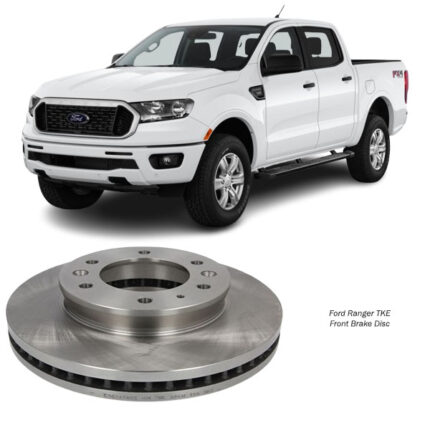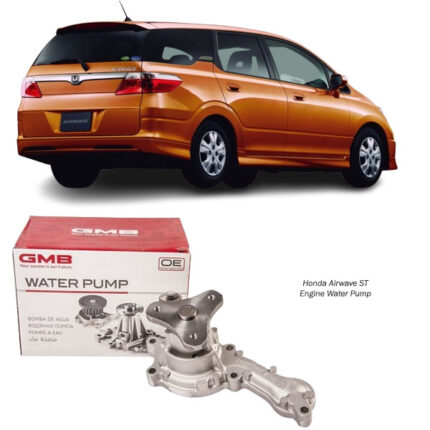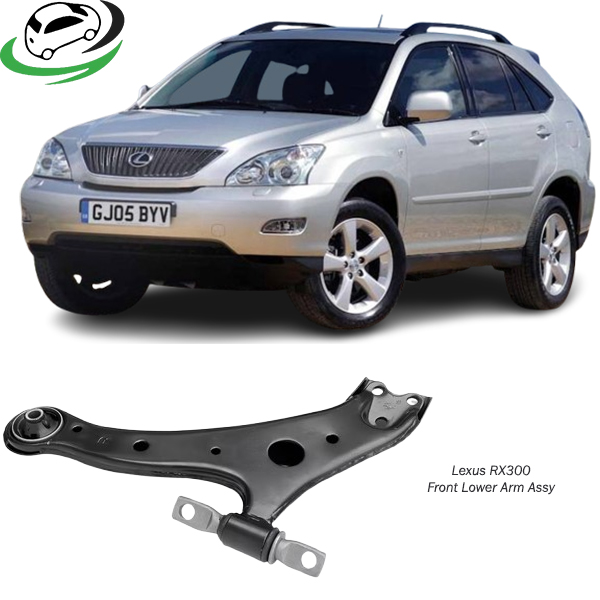Get Lexus RX300 Front Lower Arm Assy RH 48068-48030 in Kenya
The front lower arm assembly, also known as the lower control arm, is an integral part of a vehicle’s suspension system. It plays a vital role in ensuring smooth handling, effective braking, and overall vehicle stability. The front lower arm connects the vehicle’s chassis to the wheels, allowing the wheels to move up and down as the vehicle encounters bumps and uneven terrain. This component is crucial for maintaining proper alignment, minimizing tire wear, and providing responsive steering and suspension behavior.
In this article, we will explore the function, structure, types, and maintenance of the front lower arm assembly, along with common signs of wear and the replacement process. A comprehensive understanding of this suspension component can help ensure optimal vehicle performance, safety, and comfort.
1. Function and Importance of the Front Lower Arm Assembly
The front lower arm assembly connects the steering knuckle (which holds the wheel) to the vehicle chassis. It is a key part of the suspension system, designed to absorb shocks and maintain wheel alignment during driving. The main functions of the front lower arm include:
- Allowing Wheel Movement: The front lower arm allows the wheel to move up and down in response to road irregularities, helping to maintain contact between the tire and the road surface. This contributes to a smoother ride by absorbing bumps and vibrations.
- Maintaining Alignment: The front lower arm helps to ensure that the wheels remain aligned with the vehicle’s chassis, contributing to accurate steering and minimizing tire wear. Proper alignment of the suspension system is critical for handling, tire longevity, and fuel efficiency.
- Supporting Braking Forces: During braking, the front lower arm helps distribute the braking forces from the wheels to the vehicle’s chassis. This helps maintain stability and prevents the vehicle from pulling to one side.
- Allowing Steering Control: In vehicles with independent suspension systems, the front lower arm helps in maintaining precise steering control by allowing the steering knuckle to rotate when the driver turns the steering wheel.
2. Structure of the Front Lower Arm Assembly
The front lower arm assembly typically consists of several key components that work together to perform its function effectively. These components include:
- Control Arm: The control arm is the main structural component of the assembly. It is usually made from steel or aluminum, depending on the vehicle’s design. The control arm typically has a curved or straight shape, with a large mounting point at the chassis and a ball joint or bushing at the steering knuckle.
- Ball Joint: Many front lower arm assemblies feature a ball joint at the end of the control arm, which connects the control arm to the steering knuckle. The ball joint allows for the necessary range of motion between the chassis and the wheel, enabling the suspension to work smoothly while maintaining proper alignment.
- Bushings: Bushings are rubber or polyurethane components that help cushion the control arm and reduce vibrations. These bushings are located where the control arm attaches to the vehicle’s chassis or the steering knuckle. The bushings reduce noise, absorb impact forces, and improve the overall ride quality.
- Mounting Brackets: The front lower arm assembly is secured to the vehicle chassis and steering knuckle using mounting brackets, bolts, or fasteners. These brackets ensure that the suspension components stay securely in place, even under high stress and during vehicle movement.
- Stabilizer Link: In some vehicles, the front lower arm assembly may include a stabilizer link, which connects the control arm to the anti-roll bar. This helps reduce body roll during turns and enhances vehicle stability.
3. Types of Front Lower Arms
There are several different types of front lower arm assemblies, depending on the vehicle’s suspension design and intended use. The primary types of front lower arms include:
- Independent Suspension Lower Arm: In vehicles with independent front suspension (IFS), each wheel is independently attached to the chassis via a separate control arm. These lower arms are typically found in vehicles with better handling characteristics and enhanced ride quality. The independent suspension system allows each wheel to move independently, which improves traction and reduces body roll.
- MacPherson Strut Lower Arm: The MacPherson strut suspension system is common in many passenger vehicles. This type of suspension uses a strut assembly that integrates both the shock absorber and the spring into a single component. The front lower arm in this setup connects the strut to the steering knuckle and chassis, contributing to suspension performance and stability.
- Double Wishbone Lower Arm: The double wishbone suspension system uses two upper and two lower control arms (or wishbones) to control wheel movement. This design provides greater stability and better handling, particularly in performance-oriented vehicles. The lower arms in a double wishbone system are often more complex and have multiple pivot points for precise wheel control.
- Trailing Arm: In some rear-wheel-drive vehicles, the rear suspension features trailing arms, which are similar to the front lower arm but located at the rear of the vehicle. The trailing arm helps control rear wheel movement, ensuring proper alignment and ride comfort.
- Stamped Steel vs. Cast Aluminum Lower Arm: The material of the front lower arm also plays a role in its design. Stamped steel lower arms are more commonly used in older vehicles and provide a cost-effective solution. Cast aluminum lower arms are lighter and are found in more modern vehicles, offering better performance and handling characteristics.
4. Symptoms of Wear or Failure in Front Lower Arms
The front lower arm is a critical suspension component that undergoes significant wear and stress over time. If a front lower arm assembly becomes worn or damaged, it can affect the vehicle’s handling, stability, and safety. Some common symptoms of wear or failure include:
- Poor Handling or Steering Response: If the front lower arm is worn, it can cause the steering to feel unresponsive or loose. The vehicle may pull to one side, or the driver may experience difficulty controlling the vehicle, especially when turning.
- Clunking or Knocking Noises: Worn ball joints, bushings, or control arms can cause clunking or knocking sounds when driving over bumps or making turns. These noises often occur when the suspension components are no longer secure or have excessive play.
- Uneven Tire Wear: Worn front lower arms can lead to improper wheel alignment, which causes uneven tire wear. For example, the inside or outside edges of the tires may wear faster than the center, leading to the need for premature tire replacements.
- Vibrations in the Steering Wheel: Vibrations in the steering wheel, particularly at higher speeds, may indicate a problem with the front lower arm assembly. This could be caused by loose or damaged bushings or ball joints that affect the alignment of the wheels.
- Vehicle Pulling to One Side: If one of the front lower arms is damaged or worn, the vehicle may pull to one side when driving. This is usually a result of improper alignment caused by the faulty component.
5. Maintenance and Replacement of Front Lower Arm Assemblies
The front lower arm assembly requires regular inspection and maintenance to ensure the vehicle’s suspension remains in good condition. Here are some key maintenance practices and tips for replacing worn front lower arms:
- Regular Inspection: Regularly inspect the front lower arms for any signs of wear, such as cracks, rust, or loose bushings. Also, check for play in the ball joints and inspect the dust boots for damage. If any parts show signs of wear, they should be replaced immediately.
- Greasing the Ball Joints: Some lower arm assemblies have grease fittings for the ball joints. Regularly greasing the joints can help prolong their lifespan and maintain smooth suspension movement.
- Alignment Checks: After replacing the front lower arm assembly or any suspension component, it’s essential to perform a wheel alignment. Proper alignment ensures that the vehicle handles correctly, minimizes tire wear, and maintains optimal performance.
- Replacing Worn Components: If the front lower arm is damaged or worn, it is generally recommended to replace it as a complete unit. Replacing just one part (such as the bushing or ball joint) can lead to further problems down the road. It’s also advisable to replace front lower arms in pairs to maintain proper suspension symmetry.
- OEM Parts: Always use original equipment manufacturer (OEM) parts when replacing the front lower arm assembly to ensure a proper fit and maintain the vehicle’s performance standards.
6. Replacement Process
Replacing a front lower arm assembly typically involves the following steps:
- Lift the Vehicle: Secure the vehicle on a lift or jack stands, ensuring the vehicle is stable before removing the wheels.
- Remove the Old Front Lower Arm: Detach the front lower arm from the steering knuckle and the vehicle chassis by removing the fasteners and bolts.
- Install the New Front Lower Arm: Install the new front lower arm, ensuring that all fasteners are tightened to the manufacturer’s specifications.
- Perform Wheel Alignment: After replacing the front lower arm assembly, perform a wheel alignment to ensure that the vehicle’s wheels are correctly positioned.
Conclusion
The front lower arm assembly is a crucial part of a vehicle’s suspension system, directly affecting its handling, stability, and comfort. Proper maintenance and timely replacement of worn or damaged lower arms are essential for ensuring the vehicle remains safe and handles properly. By understanding the function, structure, and symptoms of a faulty front lower arm, vehicle owners can take the necessary steps to keep their suspension system in optimal condition.
Follow us on Facebook for more parts.




